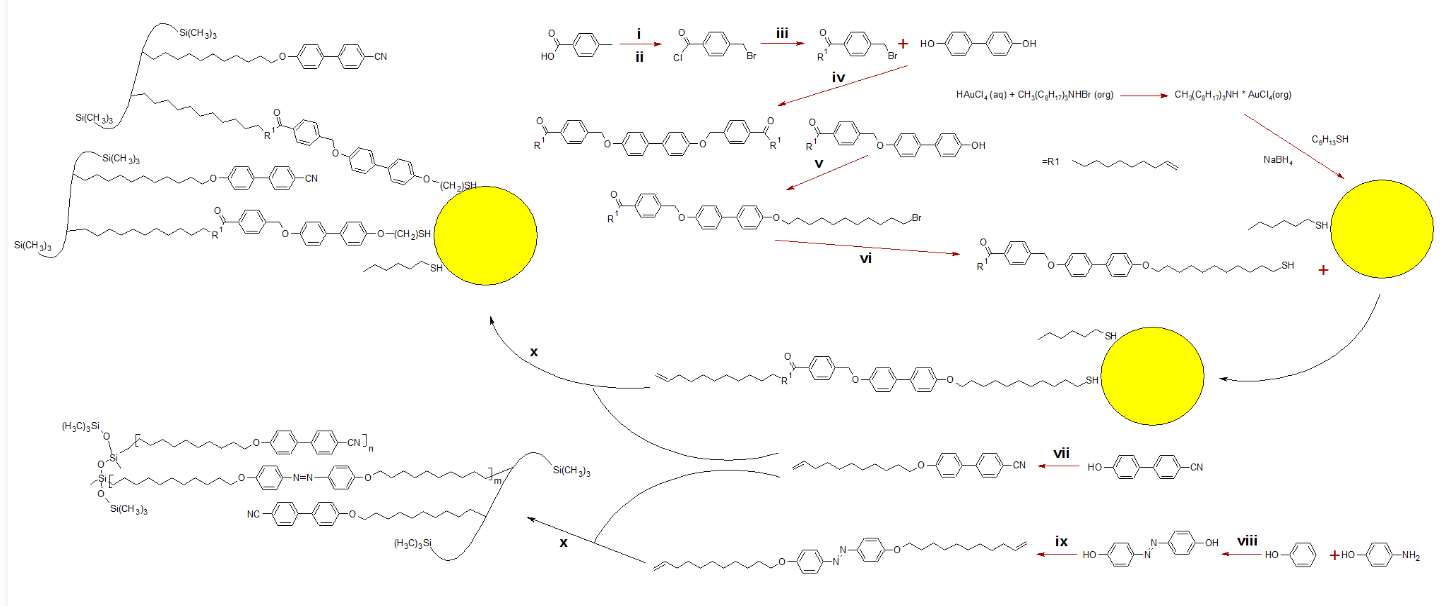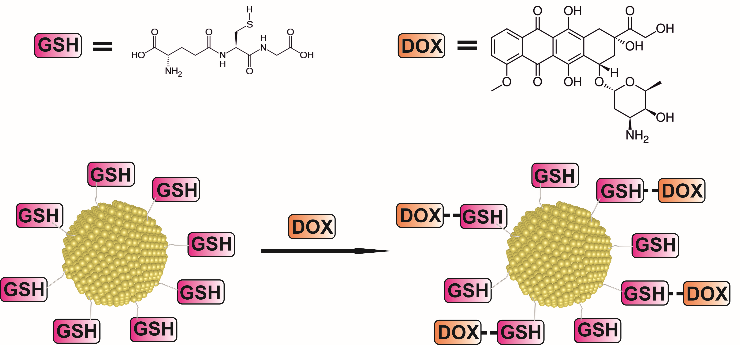The goal of the project is to master the seed-mediated synthesis of gold nanotriangles for potential applications in nanophotonics, LSPR-optical devices and SERS.

We are synthesizing liquid-crystalline molecules which are then attached to the surface of silver nanoparticles. With this approach we are able to control nanoparticles positions by changing temperature.
The work includes: organic synthesis, inorganic synthesis as well as a broad range of physicochemical examination methods (NMR, TEM, SEM,UV-Vis, XRD, POM, IR).
A long-range goal of the project is to achieve tunable metamaterials, e.g. for preparing cloaking materials.

For many years, the electronic industry has been based on inorganic semiconductors. The development of the inorganic chemistry and metallurgy and hence, the fast progress in electronic engineering only reinforced this dominance which resulted from the fact that the first synthesized organic semiconductors were intractable, showed undefined chemical structures and much worse properties than their inorganic counterparts. However, a significant progress in synthetic chemistry and in particular in heterocyclic chemistry has led to new generations of low and high molecular organic semiconductors which combine improved electronic and optoelectronic properties with solution processability, a property unattainable in inorganic semiconductors and metals.

Hybrid materials containing graphene will have enormous impact on a number of future technologies. That is why it is important to achieve controlled ways of producing hybrid structures such as graphene/nanoparticles composites. The work encompass synthesis of graphene oxide and reduced graphene oxide (techniques of organic synthesis) and a number of physicochemical examination methods (TEM, SAXS, WAXRD, TGA, XPS, UV-Vis).
The main aims of our work are: (1) the synthesis of new, solution processable semiconductors based on diketopyrrolopyrrole or naphthalene bisimide molecule, (2) the determination of their spectroscopic, electrochemical, spectroelectrochemical and structural properties (using STM technique, see Figure above) and (3) the verification of their applicability in test organic devices, namely light emitting diodes, photovoltaic cells and field effect transistors.
The purpose of the Project is to develop and obtain series of new types of liquid crystalline nanomaterials which structure contains synthetic functional molecules (mesogens) and self-organizing nanoparticles including gold, silver or iron oxide. Liquid crystal molecules provide several advantageous properties and their incorporation into nanoparticles can be utilized in the development of nanoscale smart technologies that respond to a specific external stimuli in a controlled manner. Our current efforts seek to further utilize the combination of molecular order (liquid crystalline) and responsiveness to external fields to create novel multi-functional nanomaterials of potential use in photonics and electronics.

An idealized model of multi-responsive structures made of liquid-crystalline nanoparticles (the organic molecules have been omitted for clarity), that can be controlled by light (UV-VIS), temperature (T) and magnetic field (H).
Liquid crystalline elastomers (LCEs) exhibit a number of remarkable physical effects, including a uniquely high-stroke reversible mechanical actuation triggered by external stimuli. Fundamentally, all such stimuli affect the degree of liquid crystalline order in the polymer chains cross-linked into an elastic network. Heat and the resulting thermal actuation act by promoting entropic disorder, as does the addition of solvents. Photo-isomerization is another mechanism of actuation, reducing the orientational order by diminishing the fraction of active rod-like mesogenic units, mostly studied for azobenzene derivatives incorporated into the LCE composition. Embedding nanoparticles provides a new, promising strategy to add functionality to LCEs and ultimately enhance their performance as sensors and actuators. The motivation for the combination of nanoparticles with LCEs is to provide better-controlled actuation stimuli, such as electric and magnetic fields, and broad-spectrum light, by selecting and configuring the appropriate nanoparticles in the LCE matrix.

General synthetic route to obtain LCE covalently modified with LC nanoparticles
Colloid gold nanoparticles are promising drug delivery systems (DDS) to overcome multidrug resistance, which is a main cause of ineffective chemotherapy treatment. The use of colloid gold nanoparticles as building blocks for DDSs is preferred due to ease of surface functionalization with various molecules, chemical stability and their low toxicity. Doxorubicin is a drug of choice for many cancer types treatment, however, the use of cytostatics as adjunctive treatment is limited due to their adverse side-effects and low biodistribution after intravenous administration. As a result a novel approach, we use glutathione-stabilized gold nanoparticles non-covalently modified with doxorubicin (Au-GSH-Dox) as well as we work on covalently modified nanoparticles, which requires complex organic ligands synthesis.

Synthesis scheme for the preparation of Au-GSH and Au-GSH-Dox. In the first stage gold nanoparticles covered with glutathione molecules are obtained. Then, Doxorubicin conjugation reaction is performed.
